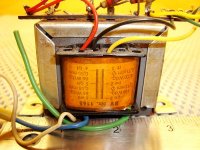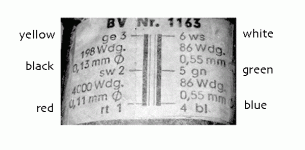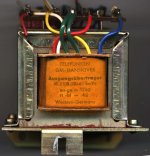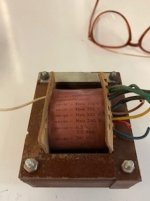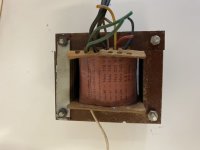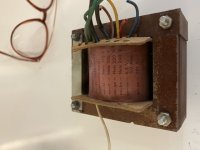Hey guys, I purchased these off eBay last winter. Wondering if any of you can tell me a bit more about them. Even wiring hookups. I'm thinking on building and RH84 with them, or something along those lines.
Model no BV-1163
Here is a picture and a quote from the original ad.
"2 VINTAGE SINGLE ENDED TELEFUNKEN OUTPUT TRANSFORMERS, FOR 6BQ5, ECL86, EL95 ETC....TYPE TUBES. THESE ARE HIGH QUALITY TRANSFORMERS, MADE IN GERMANY.
THESE TRANSFORMERS ARE IN GOOD WORKING AND COSMETIC CONDITION.
725gr WITHOUT PACKING MATERIAL."
Model no BV-1163
Here is a picture and a quote from the original ad.
"2 VINTAGE SINGLE ENDED TELEFUNKEN OUTPUT TRANSFORMERS, FOR 6BQ5, ECL86, EL95 ETC....TYPE TUBES. THESE ARE HIGH QUALITY TRANSFORMERS, MADE IN GERMANY.
THESE TRANSFORMERS ARE IN GOOD WORKING AND COSMETIC CONDITION.
725gr WITHOUT PACKING MATERIAL."
Attachments
4200 turns (whole primary) to 172 turns (whole secondary) gives 4700 : 8 Ohms, a bit higher once you add in winding resistance. Sounds good for 6V6 or any of the tubes mentioned. The tap on the primary is for a "hum-bucking" circuit - but adequate filtering is a better idea - ignore it. Tap on secondary will be 2 Ohms - not much use...
Sprechen zie deutsch?
gruen=green
blau=blue
weiss=white
gelb=yellow
schwartz=black
rot=red
Sprechen zie deutsch?
gruen=green
blau=blue
weiss=white
gelb=yellow
schwartz=black
rot=red
Do they actually say Telefunken on them?
In my data i have a TFK & a grundig OPT that start with BV, but the rest of the number is much longer.
It is pretty easy to figure out what is what, just read it off the label. The windings give you the info needed to calculate the ratios, the primamry uses the skinner wire.
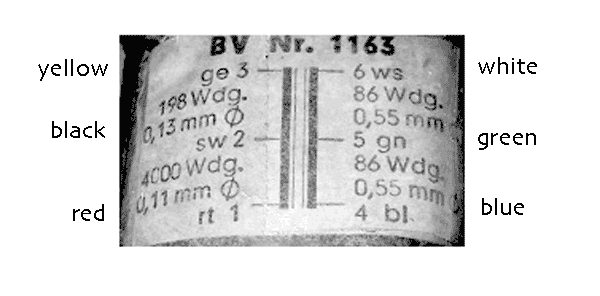
dave
Edit: Tom beat me to it, posting while i was making pretty picture
In my data i have a TFK & a grundig OPT that start with BV, but the rest of the number is much longer.
It is pretty easy to figure out what is what, just read it off the label. The windings give you the info needed to calculate the ratios, the primamry uses the skinner wire.
dave
Edit: Tom beat me to it, posting while i was making pretty picture
Attachments
... 4700 : 8 Ohms... Tap on secondary will be 2 Ohms - not much use...
Typically these German console OPTs were specced as 9400 for 4 & 8 (or 5 & 10), much higher than we use today, but likely so that they can use the same OPT for EL95 or ELL80.
dave
I'm gonna make a wild guess,so take it with a grain of salt. 
I'd say 1-2 is a primary winding(4000T),maybe even 1-3,with UL?..kinda strange ratio. Sometimes,IIRC,some OPT's had a choke section for the power supply wound on there also (perhaps 2-3.. 198Turns?) Perhaps that's the case here.
I'd guess that 4-5-6 are the secondary windings.(fewer windings of larger gauge wire)
You can figure out which winding is which with a DMM,the secondary windings will have similar,lowish resistance..The primary winding will be a higher resistance.
Dunno,just a guess.
Edit: What they said! ^^
I'd say 1-2 is a primary winding(4000T),maybe even 1-3,with UL?..kinda strange ratio. Sometimes,IIRC,some OPT's had a choke section for the power supply wound on there also (perhaps 2-3.. 198Turns?) Perhaps that's the case here.
I'd guess that 4-5-6 are the secondary windings.(fewer windings of larger gauge wire)
You can figure out which winding is which with a DMM,the secondary windings will have similar,lowish resistance..The primary winding will be a higher resistance.
Dunno,just a guess.
Edit: What they said! ^^
Thank you very much guys!
No they do not actually say Telefunken on them.
Looking forward to another project. I'll start a thread.
My first amp I built was a stereo Magnavox 142's, (PPP) with a few mods of coarse So I want to hear what all the SE fuss is about.
So I want to hear what all the SE fuss is about.
No they do not actually say Telefunken on them.
Looking forward to another project. I'll start a thread.
My first amp I built was a stereo Magnavox 142's, (PPP) with a few mods of coarse
Last edited:
The little black and white photo you attached in your earlier post looks identical to the picture in my first post.
It is from the picture you posted. I just added the translations and cropped out the label.
dave
4200 turns (whole primary) to 172 turns (whole secondary) gives 4700 : 8 Ohms, a bit higher once you add in winding resistance. Sounds good for 6V6 or any of the tubes mentioned. The tap on the primary is for a "hum-bucking" circuit - but adequate filtering is a better idea - ignore it. Tap on secondary will be 2 Ohms - not much use...
Sprechen zie deutsch?
gruen=green
blau=blue
weiss=white
gelb=yellow
schwartz=black
rot=red
Well I figured I would how to do this myself for next time.
The first time round I used a transformer to step down 120Vac to 22.6Vac - and got 0.7Vac on the secondaries.
When I did that and used my newly learned information this worked out to roughly 32:1 turns ratio, giving me an 8K into 8ohm load.
However, when I perform the test with 120Vac applied directly to the primaries I get 5K or 5.7K (depending on using the whole coil or most of it)
So that's fine it works out with what you said or by doing the math from the numbers on it.
My question is why did my test results NOT work when I used a transformer to step down the wall voltage?
Is my Multimeter not accurate enough for reading below 1 Vac?
Last edited:
A basic Fluke meter is 2% of reading +/- 2 counts on AC voltage - if you have a reading of 00.7, that's 00.5 to 00.9 - which is a +/- 28% range. If it's any other brand, check the specs - may not even be THAT good. Could be better, of course, if there's a lower range available.
And keep in mind that the winding resistance will add to the impedance seen by the output tube - add twice the primary DC resistance for a reasonable approximation (That assumes that primary and secondary have equal copper loss).
And keep in mind that the winding resistance will add to the impedance seen by the output tube - add twice the primary DC resistance for a reasonable approximation (That assumes that primary and secondary have equal copper loss).
+/- %28 is a lot, thanks for that. For future tests I will use the wall voltage for more accuracy. As long as it does not hurt the transformer.
Ok so measure the primary (ohms), multiply that by 2 and add it to the 5K or whatever the transformer may be?
I measured 1.6 ohms on the primary, so maybe I have to multiply that by the stepdown factor? 1.6 x 25 x 2 + 5K?
Looks like I have more reading to do.
AL
Ok so measure the primary (ohms), multiply that by 2 and add it to the 5K or whatever the transformer may be?
I measured 1.6 ohms on the primary, so maybe I have to multiply that by the stepdown factor? 1.6 x 25 x 2 + 5K?
Looks like I have more reading to do.
AL
Primary is probably a few hundred ohms... I'd guess about 4-500 from the wire and number of turns specified. Secondary is hard to measure unless you have a meter that goes down to milliohms.
Another way to measure the impedance including copper loss is to measure the voltage ratio with an 8 Ohm load connected. It should be at least 5W if you're measuring with 120V in.
Another way to measure the impedance including copper loss is to measure the voltage ratio with an 8 Ohm load connected. It should be at least 5W if you're measuring with 120V in.
Last edited:
Unfortunately all leads have been snipped instead of being desoldered. I bet that there are two wires each in the blue, red and yellow sleeves. You have to connect these both wires, as the primary winding is a tapped one. It goes:
white - blue 110 Vac
white - red 125 Vac
white - yellow 220 Vac
white - brown 240 Vac
The secondaries are:
black - black 6.3 Vac 3 A
green - green 261 Vac
Best regards!
white - blue 110 Vac
white - red 125 Vac
white - yellow 220 Vac
white - brown 240 Vac
The secondaries are:
black - black 6.3 Vac 3 A
green - green 261 Vac
Best regards!
- Status
- This old topic is closed. If you want to reopen this topic, contact a moderator using the "Report Post" button.
- Home
- Amplifiers
- Tubes / Valves
- Anybody know this TELEFUNKEN SE transformer?
